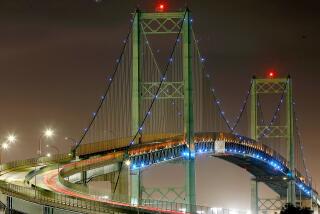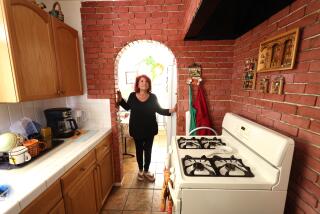OK Seen for Toll Lanes on Riverside Freeway : Transportation: Local panel to consider plan for project along median that would link up with car-pool lanes in Riverside County.
- Share via
SANTA ANA — After months of wrangling with their counterparts in the Inland Empire, Orange County’s transportation czars today will get a chance to put their stamp of approval on an agreement that should ultimately make life easier for traffic-weary commuters on the Riverside Freeway.
The Orange County Transportation Authority will consider an agreement that should topple the last formidable obstacle to a private firm’s plans to spend $100 million to build a set of toll lanes down the freeway’s gravelly center median.
If the agency ratifies the agreement as expected and all else goes according to plans, the toll lanes, which will stretch for 10 miles from the Costa Mesa Freeway to the county line, should be under construction by late summer and the first phase open for business by 1994.
The toll project would link up with car-pool lanes along the freeway in Riverside County that are now under construction and expected to be fully completed by 1993. The Riverside County Transportation Commission on Wednesday narrowly approved the agreement, which was also signed by officials from the California Department of Transportation and the firm planning the project, California Private Transportation Corp.
Aside from offering workaday commuters a few extra lanes to help ease the daily grind on the Riverside Freeway, the project represents the state’s first effort to have a private firm build and operate a highway project.
In addition, the toll lanes are expected to mark the first true test in the United States of “congestion pricing,” the concept of charging motorists more to use a highway during peak hours.
Authorities with California Private Transportation Corp. say they are anticipating a one-way charge of $2 during peak hours compared to a $1 toll at off-peak. The idea is that the extra cost will motivate some motorists to stay off the freeway during rush hours.
“From time to time, various toll roads have experimented with off-peak pricing,” said Gerald Pfeffer, president of California Private Transportation Corp., a subsidiary of the Texas-based engineering firm CRSS Inc. “But none have made the kind of in-depth commitment that we plan, nor have they had a side-by-side test of a variable toll with a free facility.”
Boosters of the concept are eager to see the results.
“I see this as a prototype for what I hope will be happening all over this country in the coming decade,” said Robert W. Poole Jr., president of the Reason Foundation, a Los Angeles-based think tank that has championed congestion pricing. “If this shows that the pricing mechanism can keep traffic flowing more freely, I think the whole country will pay close attention.”
The agreement also represents something of a watershed in relations between Orange and Riverside counties. The two counties in recent years have warred repeatedly over everything from regional airports to trash dump sites. The toll lanes have also been caught in the tug of war, with Riverside County officials threatening to sue over the private project.
When the toll project was first unveiled by Caltrans in 1990, Riverside County officials were angered because it threatened to put thousands of Inland Empire motorists in the position of paying twice to use the lanes: Once for a voter-approved sales tax to help fund the car-pool lanes and again with a fee for the toll lanes.
Such concerns were much in evidence last Wednesday, as Riverside County transportation officials approved the agreement on a 4-3 vote, with the three county supervisors sitting on the commission in dissent.
Supervisor Kay Ceniceros said she opposed the agreement in part because it uses existing public right of way for a private, moneymaking venture. She was also irked that Orange County transportation officials backed away from a promise to use public money to build car-pool lanes along the entire length.
“I appreciate the work done by all the parties that makes the toll road a less obnoxious project,” said Ceniceros, chairwoman of the commission. “But the bottom line is it’s poor public policy. Since there had been a previous indication that Orange County would help finance car-pool lanes on the 91, I do feel like they pulled the rug out from under us.”
Under the agreement, car pools with three or more occupants ride free on the toll lanes. Riverside County had been pushing for months to allow two or more to ride free, fearing that otherwise the toll lanes would be worthless to a large number of motorists using the car-pool lanes, where vehicles must have only two occupants.
Ultimately, a majority of the Riverside County commissioners decided that compromise was in order and litigation would only delay some form of traffic relief for beleaguered commuters. But even the man who negotiated the agreement for Riverside County, commission Executive Director Jack Reagan, seemed less than thrilled after the vote.
“We just tried to make as silky a purse as we could out of a sow’s ear,” Reagan said.
Despite continued grumbling from the Inland Empire contingent, officials in Orange County are gleeful the battle with Riverside County has been resolved. Many suggest that the compromise has resulted in a better project. Aside from mandating that car pools with three or more ride free, the agreement settles several other issues:
* All parties would work together to obtain state legislation that would require Caltrans to spend excess revenue specifically on the Riverside Freeway corridor instead of funneling the money into the state highway account.
* California Private Transportation Corp. agreed to spend up to 3% of its profit on transportation projects selected by the counties such as park-and-ride lots, buses or possibly commuter rail.
* The firm agrees to reimburse OCTA for $5 million in costs the agency incurred for preliminary engineering and environmental work performed in recent years for lanes planned along the route.
* Car pools would be loaned free electronic “transponders,” the devices that will be used to bill motorists for tolls. Other people using the toll lanes will be charged a rental fee for the transponders, in the neighborhood of $2 a month.
“This is all very good news,” said Dana Reed, an OCTA board member. “Hopefully this is the last big hurdle. I have heard no opposition at all on our board in Orange County.”
Although the project still awaits final environmental approvals from the state and federal governments, it has not received the sort of rough treatment handed out to a trio of tollways planned in southern Orange County by a coalition of cities and the county working with developers.
“We don’t have the same strong objections to the 91 toll project that we have to the other three toll roads,” said Michael Fitts, an attorney with the Natural Resources Defense Council, a national environmental group challenging the South County tollways. “It runs on an existing median and it’s not going through pristine areas like the other three roads. Additionally, we’re encouraged that the project’s proponent is willing to make a meaningful step to encourage car-pooling by allowing three to go free.”
Tollway Proposed
The Orange County Transportation Authority will consider an agreement that would pave the way for construction of a 10-mile stretch of toll lanes linking with car-pool lanes now being built in Riverside County. The $100-million project, featuring two lanes in each direction, could be under construction by late summer, with the first phase open in 1994 and the entire project completed in 1995. Tolls are expected to be $2 during peak commuting hours and $1 the rest of the time.
More to Read
Sign up for Essential California
The most important California stories and recommendations in your inbox every morning.
You may occasionally receive promotional content from the Los Angeles Times.










